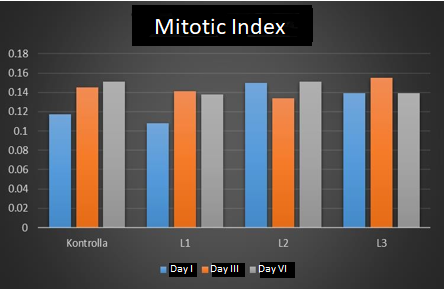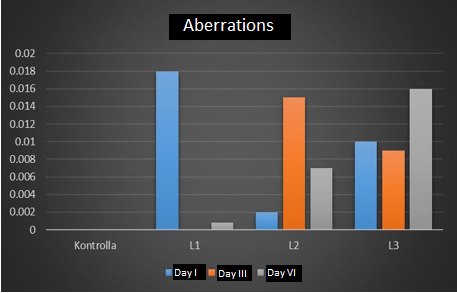Written by Tringi Studies
Results and Discussion
The results of the research are presented in tabular and graphical form.
Table I presents the data for the mitotic index, the frequency of micronuclei, and chromosomal aberrations caused by the applied concentrations (100%) of water from the Llapi River, as well as the control group using distilled water.
Table II and Figure 1 display the effect of Llapi River water concentration on the mitotic index over treatment periods of 1, 3, and 6 days. The values shown represent the averages from three experiments.
Table III and Figure 2 illustrate the impact of the Llapi River water concentration on the frequency of chromosomal aberrations. The average values of three experiments are presented for treatments lasting 1, 3, and 6 days.
Table IV shows the effect of the Llapi River water concentration on the frequency of micronuclei. The average values from three experiments are presented for the 1-, 3-, and 6-day treatments.
| Treatment | Location | Micronuclei | Aberrations | Mitotic index |
| Day 1 | Control | 0.016 ± 0.035 | 0.520 ± 1.162 | 0.140 ± 0.014 |
| L1 | 0.000 ± 0.000 | 1.360 ± 3.041 | 0.152 ± 0.012 | |
| L2 | 0.020 ± 0.044 | 3.822 ± 1.281 | 0.152 ± 0.004 | |
| L3 | 0.000 ± 0.000 | 1.016 ± 1.395 | 0.151 ± 0.011 | |
| Day 3 | Control | 0.000 ± 0.000 | 0.000 ± 0.000 | 0.142 ± 0.013 |
| L1 | 0.000 ± 0.000 | 0.000 ± 0.000 | 0.148 ± 0.007 | |
| L2 | 0.016 ± 0.035 | 2.104 ± 2.738 | 0.150 ± 0.018 | |
| L3 | 0.000 ± 0.000 | 0.400 ± 0.983 | 0.147 ± 0.017 | |
| Day 6 | Control | 0.000 ± 0.000 | 0.000 ± 0.000 | 0.156 ± 0.012 |
| L1 | 0.000 ± 0.000 | 0.000 ± 0.000 | 0.154 ± 0.012 | |
| L2 | 0.016 ± 0.035 | 2.088 ± 2.151 | 0.160 ± 0.007 | |
| L3 | 0.054 ± 0.049 | 0.976 ± 1.339 | 0.151 ± 0.008 |
| Location | Day 1 | Day 3 | Day 6 |
| Control | 0.117 ± 0.027 | 0.145 ± 0.010 | 0.151 ± 0.010 |
| L1 | 0.108 ± 0.009 | 0.141 ± 0.008 | 0.138 ± 0.006b |
| L2 | 0.150 ± 0.012a | 0.134 ± 0.009 | 0.151 ± 0.010 |
| L3 | 0.139 ± 0.016 | 0.155 ± 0.011 | 0.139 ± 0.006c |
ap<0.052 (compared to the respective control)
bp<0.052 (compared to the respective control)
cp<0.058 (compared to the respective control)

| Location | Day 1 | Day 3 | Day 6 |
| Control | 0.000 ± 0.000 | 0.000 ± 0.000 | 0.000 ± 0.000 |
| L1 | 0.018 ± 0.020 | 0.000 ± 0.000 | 0.084 ± 0.011 |
| L2 | 0.002 ± 0.004 | 0.015 ± 0.014 | 0.007 ± 0.010 |
| L3 | 0.010 ± 0.014 | 0.009 ± 0.013 | 0.016 ± 0.017 |

| Location | Day 1 | Day 3 | Day 6 |
| Control | 0.0002 ± 0.0004 | 0.000 ± 0.000 | 0.000 ± 0.000 |
| L1 | 0.0002 ± 0.0004 | 0.000 ± 0.000 | 0.000 ± 0.000 |
| L2 | 0.0000 ± 0.0000 | 0.000 ± 0.000 | 0.000 ± 0.000 |
| L3 | 0.0000 ± 0.0000 | 0.000 ± 0.000 | 0.000 ± 0.000 |
Discussion
The lack of wastewater treatment plants and the discharge of such waters into surface water bodies have contributed to an increased level of pollution. Additionally, the overexploitation of rivers has led to numerous consequences such as the endangerment and disappearance of biodiversity, degradation of riverbeds, and flooding (AMMK, 2015).
Surface and groundwater pollution from mining activities, landfills, and domestic and industrial wastewater continues to threaten water supply (Schwarzenbach et al., 2010).
Furthermore, environmental pollution (from industry, power plants, and motor vehicles) contributes to the occurrence of various diseases such as cancer (Cohen, 2000), skin diseases (irritations that result in wounds), and gastrointestinal issues (ulcers) as a direct or indirect result of wastewater discharges (Halder & Islam, 2015).
According to studies (Alija et al., 2015), individuals exposed to industrial pollution in Kosovo (Kastriot and Obiliq) show increased genetic damage (DNA) in human leukocytes compared to control individuals (Pejë).
The results obtained from this study on the Llapi River water samples did not show genotoxic effects in terms of the frequency of micronuclei and chromosomal aberrations.
However, during the 1-day and 6-day treatments, the water samples did show cytotoxic effects in terms of the mitotic index. Specifically, at location L2–Podujevë (1-day treatment), differences were observed that are close to being statistically significant (p < 0.052). Similar differences were also observed on day 6 at locations L1–Pollatë (p<0.052) and L3–Lupç (p<0.058).
In this context, it is important to emphasize that rivers (in this case, the Llapi River) are exposed to discharges from domestic, agricultural, and partially industrial sources. Therefore, continuous monitoring of such parameters (both physical and chemical) is necessary in order to properly interpret the results of this research. This study was conducted with water samples collected at the beginning of September and at least ten days after the cessation of rainfall.
Conclusion
The water samples from the Llapi River treated for 1, 3, and 6 days in this study did not show genotoxic effects regarding the frequency of micronuclei.
The water samples from the 1-, 3-, and 6-day treatments taken from the Llapi River did not show genotoxic effects in terms of chromosomal aberration frequency.
The analyzed water samples showed cytotoxic effects based on the mitotic index when compared to the control. The 1-day treatment (L2–Podujevë) showed a cytotoxic effect (p<0.052). Similarly, differences (p<0.052 and p<0.058) were observed in the 6-day treatment samples from L1–Pollatë and L3–Lupç regarding the mitotic index.
The results of this study are specific to the summer season (September) of 2018; therefore, it is recommended that ongoing research be conducted that includes different concentrations and longer time periods to identify seasonal and annual variations.
Based on the indications identified in this study’s results, further research using this test object (Allium) is necessary, as well as studies in animal cells, in order to more accurately assess the potential risk to environmental health, human health, and other organisms.
References
Alija, A. J., Asllani, F., Bajraktari, I. D., Collins, A. R., Dreshaj, S., Bresgen, N., & Eckl,
P. M. (2016). Atmospheric pollution in Kosovo is associated with increased DNA damage in the human population. Biomonitoring, 2(1). doi:10.1515/bimo-2015-0006
AMMK (2015). Raport për gjendjen e mjedisit në Kosovë. Ministria e Mjedisit dhe Planifikimit Hapësinor, Prishtinë.
Cohen, A. J. (2000). Outdoor Air Pollution and Lung Cancer. Environmental Health Perspectives, 108, 743. doi:10.2307/345441.
Halder, J.N. & Islam, M.N. (2015). Water pollution and its impact on human health.
Journal of Environment and Human, 2(1), pp. 36-46. DOI: 10.15764/EH.2015.01005.
Schwarzenbach, R. P., Egli, T., Hofstetter, T. B., von Gunten, U., & Wehrli, B. (2010). Global Water Pollution and Human Health. Annual Review of Environment and Resources, 35(1), 109–136. doi:10.1146/annurev-environ-100809-125342.
Disclaimer: This article is for informational and educational purposes only.